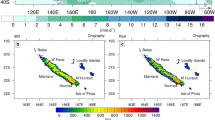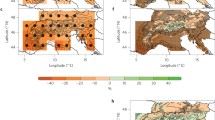Abstract
Change to precipitation in a warming climate holds many implications for water management into the future, and an enhancement of a precipitation decrease or increase on or around mountains would have numerous impacts. Here, an intermediate resolution regional climate model (RCM) ensemble projects enhanced precipitation decrease on the windward slopes of over many mid-latitude mountains in winter, consistent with theory and model studies of idealised mountain ranges. This ensemble projects that an increase in convective rainfall determines the sign of total rainfall change in many regions in summer, only some of which are on or near mountains such as the European Alps. These same projected changes are present in inland slopes of the Australian Alps compared to surrounding regions as simulated by three RCM ensembles (the intermediate resolution and two high resolution ensembles), which agree on an enhanced precipitation decrease on the windward slopes in winter and spring, as well as an enhanced precipitation increase in summer driven by an increase in convective rainfall. The ensembles disagree on an enhanced precipitation decrease in autumn. The results represent regional-scale added value in the climate change signal of projections from high resolution models in cooler seasons, but suggest that the specific model components such as convection schemes strongly influence projections of summer rainfall change. Confidence in the simulation of change in convective rainfall, or convection-permitting modelling may be needed to raise confidence in summer rainfall projections over mountains.









Similar content being viewed by others
References
Ban N, Schmidli J, Schär C (2015) Heavy precipitation in a changing climate: does short-term summer precipitation increase faster? Geophys Res Lett 42:1165–1172
Beniston M, Stoffel M (2014) Assessing the impacts of climatic change on mountain water resources. Sci Total Environ 493:1129–1137
Cannon DJ, Kirshbaum DJ, Gray SL (2012) Under what conditions does embedded convection enhance orographic precipitation? Q J R Meteorol Soc 138:391–406
Chou C, Chen C-A, Tan P-H, Chen KT (2012) Mechanisms for global warming impacts on precipitation frequency and intensity. J Clim 25:3291–3306
Collins M et al (2013) Long-term climate change: projections, commitments and irreversibility. In: Stocker TF, Qin D, Plattner G-K et al (eds) Climate change 2013: the physical science basis. Contribution of working group I to the fifth assessment report of the intergovernmental panel on climate change. Cambridge University Press, Cambridge, pp 1029–1136. https://doi.org/10.1017/CBO9781107415324.024
Dezfuli AK, Zaitchik BF, Badr HS, Evans J, Peters-Lidard CD (2017) The role of low-level, terrain-induced jets in rainfall variability in tigris–euphrates headwaters. J Hydrometeorol 18:819–835
Di Luca A, Elía R, Laprise R (2012) Potential for small scale added value of RCM’s downscaled climate change signal. Clim Dyn 40:601–618
Di Luca A, Argüeso D, Evans JP, de Elía R, Laprise R (2016) Quantifying the overall added value of dynamical downscaling and the contribution from different spatial scales. J Geophys Res Atmos 121:1575–1590
Eidhammer T, Grubišić V, Rasmussen R, Ikdea K (2018) Winter precipitation efficiency of mountain ranges in the colorado rockies under climate change. J Geophys Res Atmos. https://doi.org/10.1002/2017JD027995
Evans J, Ekström M, Ji F (2012) Evaluating the performance of a WRF physics ensemble over South-East Australia. Clim Dyn 39:1241–1258
Evans JP, Ji F, Lee C, Smith P, Argüeso D, Fita L (2014) Design of a regional climate modelling projection ensemble experiment; NARCliM. Geosci Model Dev 7:621–629
Evans JP, Argüeso D, Olson R, Di Luca A (2016) Bias-corrected regional climate projections of extreme rainfall in south-east Australia. Theor Appl Climatol. https://doi.org/10.1007/s00704-016-1949-9
Fiddes SL, Pezza AB (2015) Current and future climate variability associated with wintertime precipitation in alpine Australia. Clim Dyn 44:2571–2587
Fiddes SL, Pezza AB, Barras V (2015) Synoptic climatology of extreme precipitation in alpine Australia. Int J Climatol 35:172–188
Fischer AM, Keller DE, Liniger MA, Rajczak J, Schär C, Appenzeller C (2015) Projected changes in precipitation intensity and frequency in Switzerland: a multi-model perspective. Int J Climatol 35:3204–3219
Fu G, Charles SP, Chiew FHS, Ekström M, Potter NJ (2018) Uncertainties of statistical downscaling from predictor selection: equifinality and transferability. Atmos Res 203:130–140
Gao X, Xu Y, Zhao Z, Pal JS, Giorgi F (2006) On the role of resolution and topography in the simulation of East Asia precipitation. Theor Appl Climatol 86:173–185
Gilliland EK, Lincoln NE, Rowe CM (2007) A comparison of cumulus parameterization schemes in the WRF model. In: 87th American meteorological society meeting. San Antonio, Texas, USA
Giorgi F, Hurrell JW, Marinucci MR, Beniston M (1997) Elevation dependency of the surface climate change signal: a model study. J Clim 10:288–296
Giorgi F, Torma C, Coppola E, Ban N, Schar C, Somot S (2016) Enhanced summer convective rainfall at Alpine high elevations in response to climate warming. Nat Geosci 9:584–589
Gobiet A, Kotlarski S, Beniston M, Heinrich G, Rajczak J, Stoffel M (2014) 21st century climate change in the European Alps—a review. Sci Total Environ 493:1138–1151
Grose M, Barnes-Keoghan I, Corney S, White C, Holz G, Bennett J, Gaynor S, Bindoff N (2010) Climate futures for Tasmania: general climate impacts technical report. Hobart, Australia, Antarctic Climate and Ecoststems CRC
Harris RMB, Remenyi T, Bindoff NL (2016) The potential impacts of climate change on victorian alpine resorts. A Report to the Alpine Resorts Co-ordinating Council. Hobart, Australia, Antarctic Climate and Ecosystems Cooperative Research Centre
Held IM, Soden BJ (2006) Robust responses of the hydrological cycle to global warming. J Clim 19:5686–5699
Im ES, Coppola E, Giorgi F, Bi X (2010) Local effects of climate change over the Alpine region: a study with a high resolution regional climate model with a surrogate climate change scenario. Geophys Res Lett 37:6
Jerez S, López-Romero JM, Turco M, Jiménez-Guerrero P, Vautard R, Montávez JP (2018) Impact of evolving greenhouse gas forcing on the warming signal in regional climate model experiments. Nat Commun 9:1304
Jones DA, Wang W, Fawcett R (2009) High-quality spatial climate data-sets for Australia. Aust Meteorol Oceanogr J 58:233–248
Kain JS (2004) The Kain–Fritsch convective parameterization: an update. J Appl Meteorol 43:170–181
Kalnay E et al (1996) The NCEP/NCAR 40-year reanalysis project. Bull Am Meteorol Soc 77:437–471
Karl TR, Nicholls N, Ghazi A (1999) CLIVAR/GCOS/WMO Workshop on indices and indicators for climate extremes workshop summary. In: Karl TR, Nicholls N, Ghazi A (eds) Weather and climate extremes: changes, variations and a perspective from the insurance industry. Springer, Dordrecht, pp 3–7. https://doi.org/10.1007/978-94-015-9265-9_2
Katragkou E et al (2015) Regional climate hindcast simulations within EURO-CORDEX: evaluation of a WRF multi-physics ensemble. Geosci Model Dev 8:603–618
Katzfey JJ et al (2016) High-resolution simulations for Vietnam—methodology and evaluation of current climate. Asia Pac J Atmos Sci 52:91–106
Kendon EJ et al (2017) Do convection-permitting regional climate models improve projections of future precipitation change? Bull Am Meteorol Soc 98:79–93
Kotlarski S, Bosshard T, Lüthi D, Pall P, Schär C (2012) Elevation gradients of European climate change in the regional climate model COSMO-CLM. Clim Change 112:189–215
Leung LR, Ghan SJ (1999) Pacific northwest climate sensitivity simulated by a regional climate model driven by a GCM. Part II: 2 × CO2 simulations. J Clim 12:2031–2053
McGregor JL (2003) A new convection scheme using a simple closure. BMRC Res Rep 93:33–36
McGregor JL, Dix MR (2008) An updated description of the conformal-cubic atmospheric model. In: Hamilton K, Ohfuchi W (eds) High resolution simulation of the atmosphere and ocean. Springer, New York, pp 51–76
McGregor JL, Nguyen KC, Kirono DGC, Katzfey JJ (2016) High-resolution climate projections for the islands of Lombok and Sumbawa, Nusa Tenggara Barat Province, Indonesia: challenges and implications. Clim Risk Manag 12:32–44
Meehl GA, Covey C, Delworth T, Latif M, McAvaney B, Mitchell JFB, Stouffer RJ, Taylor KE (2007) The WCRP CMIP3 multimodel dataset—a new era in climate change research. Bull Am Meteorol Soc 88:1383–1394
Minder JR, Letcher TW, Liu C (2018) The character and causes of elevation-dependent warming in high-resolution simulations of rocky mountain climate change. J Clim 31:2093–2113
Nakicenovic N et al (2000) Special report on emissions scenarios. A special report of working group III of the intergovernmental panel on climate change. Cambridge University Press, Cambridge
Olson R, Evans JP, Di Luca A, Argüeso D (2016) The NARCliM project: model agreement and significance of climate projections. Clim Res 69:209–227
Paeth H, Pollinger F, Mächel H, Figura C, Wahl S, Ohlwein C, Hense A (2017) An efficient model approach for very high resolution orographic precipitation. Q J R Meteorol Soc 143:2221–2234
Pavelsky TM, Sobolowski S, Kapnick SB, Barnes JB (2012) Changes in orographic precipitation patterns caused by a shift from snow to rain. Geophys Res Lett. https://doi.org/10.1029/2012GL052741
Prein AF et al (2015) A review on regional convection-permitting climate modeling: demonstrations, prospects, and challenges. Rev Geophys 53:323–361
Ragone F, Mariotti M, Parodi A, Von Hardenberg J, Pasquero C (2018) A climatological study of western mediterranean medicanes in numerical simulations with explicit and parameterized convection. Atmosphere 9:397
Rangwala I, Miller JR (2012) Climate change in mountains: a review of elevation-dependent warming and its possible causes. Clim Change 114:527–547
Salazar A, Katzfey JJ, Thatcher M, Syktus JI, Wondg K, McAlpine C (2016) Deforestation changes land–atmosphere interactions across South American biomes. Glob Planet Change 139:97–108
Shi X, Durran DR (2014) The response of orographic precipitation over idealized midlatitude mountains due to global increases in CO2. J Clim 27:3938–3956
Shi X, Durran DR (2015) Estimating the response of extreme precipitation over midlatitude mountains to global warming. J Clim 28:4246–4262
Shi X, Durran D (2016) Sensitivities of extreme precipitation to global warming are lower over mountains than over oceans and plains. J Clim 29:4779–4791
Siler N, Durran D (2016) What causes weak orographic rain shadows? Insights from case studies in the cascades and idealized simulations. J Atmos Sci 73:4077–4099
Siler N, Roe G (2014) How will orographic precipitation respond to surface warming? An idealized thermodynamic perspective. Geophys Res Lett 41:2606–2613
Su CH et al (2018) BARRA v1.0: the bureau of meteorology atmospheric high-resolution regional reanalysis for Australia. Geosci Model Dev Discuss 2018:1–33
Syktus JI, McAlpine C (2016) More than carbon sequestration: biophysical climate benefits of restored savanna woodlands. Sci Rep 6:29194
Taylor KE, Stouffer RJ, Meehl GA (2012) An overview of CMIP5 and the experiment design. Bull Am Meteorol Soc 93:485–498
Thatcher M, McGregor JL (2011) A technique for dynamically downscaling daily-averaged GCM datasets using the conformal cubic atmospheric model. Mon Weather Rev 139:79–95
Torma C, Giorgi F, Coppola E (2015) Added value of regional climate modeling over areas characterized by complex terrain—precipitation over the Alps. J Geophys Res Atmos 120:3957–3972
van Vuuren D et al (2011) The representative concentration pathways: an overview. Clim Change 109:5–31
Wong K, Syktus JI, Jeffrey S, Toombs N, Rotstayn L (2011) Climate extremes during the 20th and 21st centuries simulated by the CSIRO Mk3.6 climate model with anthropogenic and natural forcings. Modelling & Simulation Society of Australia & New Zealand, Perth
Acknowledgements
This work was supported by the Australian Government’s National Environmental Science Program’s Earth System and Climate Change hub, the Victorian Government’s Department of Environment Land Water and Planning climate projections 2019 project (VCP19), Queensland Climate Adaptation Strategy (Q-CAS) and the Wine Australia Institute climate project. We thank John McGregor and Jack Katzfey from CSIRO for additional modelling support, helpful advice and assistance.
Author information
Authors and Affiliations
Corresponding author
Additional information
Publisher’s Note
Springer Nature remains neutral with regard to jurisdictional claims in published maps and institutional affiliations.
Electronic supplementary material
Below is the link to the electronic supplementary material.
Rights and permissions
About this article
Cite this article
Grose, M.R., Syktus, J., Thatcher, M. et al. The role of topography on projected rainfall change in mid-latitude mountain regions. Clim Dyn 53, 3675–3690 (2019). https://doi.org/10.1007/s00382-019-04736-x
Received:
Accepted:
Published:
Issue Date:
DOI: https://doi.org/10.1007/s00382-019-04736-x




